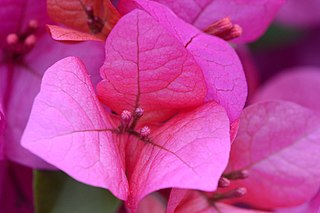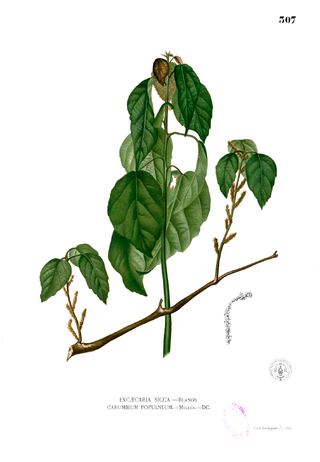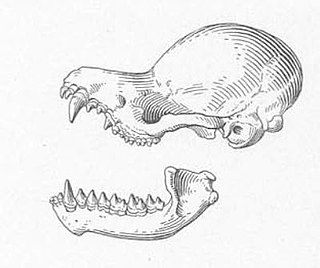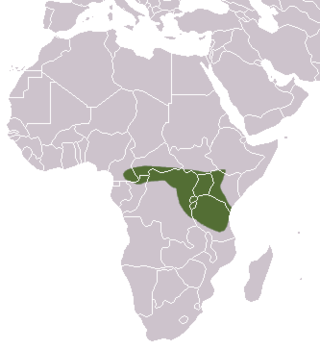
Bougainvillea is a genus of thorny ornamental vines, bushes, and trees belonging to the four o' clock family, Nyctaginaceae. It is native to eastern South America, found from Brazil, west to Peru, and south to southern Argentina. Different authors accept from 4 to 22 species in the genus. The inflorescence consists of large colourful sepal-like bracts which surround three simple waxy flowers, gaining popularity for the plant as an ornamental.

Inula is a genus of about 80 species of flowering plants in the family Asteraceae, native to Europe, Asia and Africa.

Alchornea is a plant genus of the family Euphorbiaceae first described as a genus in 1788. It is widespread in tropical and subtropical regions of Africa, South Asia, Australia, Latin America, and various oceanic islands. Molecular phylogenetic analyses suggest that Bocquillonia from New Caledonia is nested in Alchornea.

The oribi is a small antelope found in eastern, southern and western Africa. The sole member of its genus, it was described by the German zoologist Eberhard August Wilhelm von Zimmermann in 1783. While this is the only member in the genus Ourebia, eight subspecies are identified. The oribi reaches nearly 50–67 centimetres (20–26 in) at the shoulder and weighs 12–22 kilograms (26–49 lb). It possesses a slightly raised back, and long neck and limbs. The glossy, yellowish to rufous brown coat contrasts with the white chin, throat, underparts and rump. Only males possess horns; the thin, straight horns, 8–18 centimetres (3.1–7.1 in) long, are smooth at the tips and ringed at the base.
Athroisma is a genus of plants in the family Asteraceae first described as a genus in 1833. It is native to East Africa and Madagascar.

Drypetes is a plant genus of the family Putranjivaceae, in the order Malpighiales.

Minuartia is a genus of flowering plants commonly known as sandworts in the family Caryophyllaceae.

Emilia is a genus of herbaceous plants in the family sunflower family, known as tasselflower or pualele.
Aellen's pipistrelle is a species of vesper bat. It can be found in possibly Benin, Cameroon, Ghana, Nigeria, and Sierra Leone. It is found in dry and moist savanna.

The copper woolly bat is a species of vesper bat. It is found in Cameroon, Democratic Republic of the Congo, Ivory Coast, and Guinea. Its natural habitats are subtropical or tropical dry forests, subtropical or tropical moist lowland forests, and subtropical or tropical swamps. It is threatened by habitat loss.
The dark-brown serotine is a species of vesper bat found in Central and West Africa.

Hildegarde's shrew is a species of mammal in the family Soricidae. It is found in Burundi, Cameroon, Central African Republic, Republic of the Congo, Democratic Republic of the Congo, Ethiopia, Kenya, Rwanda, and Tanzania. Considered by some authorities to be a subspecies of Crocidura gracilipes, it is now recognised as a separate species, with a diploid chromosome number of 2n = 52. This is one of three species of small mammal named by the British zoologist Oldfield Thomas in honour of anthropologist Hildegarde Beatrice Hinde.

The Xerinae comprise a subfamily of squirrels, many of which are highly terrestrial. It includes the tribes Marmotini, Xerini, and Protoxerini.

Hypochaeris glabra is a species of flowering plant in the tribe Cichorieae within the family Asteraceae known by the common name smooth cat's ear. It is native to Europe, North Africa, and the Middle East but it can be found on other continents where it is an introduced species and a widespread weed. It has become widespread in Africa, southern and southeastern Asia, Australia, and parts of the Americas.

Nolletia is a genus of flowering plants in the tribe Astereae within the family Asteraceae. The genus was named in honour of Jean-Antoine Nollet, French clergyman and physicist.

Jaumea is a genus of flowering plants in the family Asteraceae. The plants are sprawling perennial herbs branching mostly from the base. Flower heads are yellow, with disc flowers and also usually with ray flowers.
Neurolakis is a genus of flowering plants in the tribe Vernonieae within the family Asteraceae.

Margi, also known as Marghi and Marghi Central, is a Chadic language spoken in Nigeria, Cameroon, and Chad. It is perhaps the best described of the Biu–Mandara branch of that family. Marghi South language and Putai are closely related and sometimes considered dialects of Margi.

Landolphia is a genus of flowering plants in the family Apocynaceae first described as a genus in 1806. They take the form of vines that scramble over host trees. Landolphia is native to tropical Africa.
Bursellia is a genus of African dwarf spiders that was first described by Å. Holm in 1962.















